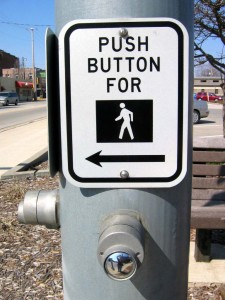 Being at a loss for words can sometimes be beneficial.
Being at a loss for words can sometimes be beneficial.
For example, consider these common sayings:
- A picture is worth a 1,000 words.
- Actions speak louder than words.
- Sticks and stones may break my bones, but words will never hurt me.
These truisms came to mind after participating in BJ Fogg’s day-long refresher boot camp in persuasion and behavior design.
Two dozen of us alums gathered to hear what BJ was working on now as well as review our earlier lessons.
As the founder of the Persuasive Technology Lab at Stanford, BJ says that one of the top 10 mistakes in behavior change is believing that information leads to action. We’re just not that rational.
What causes behavior change? In his Fogg Behavior Model, action happens when three elements converge at the same moment: motivation, ability and trigger. This convergence makes his behavior model different from others.
Also, the model shows a tradeoff between motivation and ability. If someone has high ability, their motivation to do a behavior can be low—provided they have a compelling trigger. And vice versa.
This model is very practical and useful for those who use technology in designing for behavior change.
As an aside, if you’ve ever succumbed to an offer on Groupon or LivingSocial more because it was easy rather than because the service or product was something you couldn’t live without, you experienced a hot trigger. You had the ability to successfully click a button even if you weren’t wildly motivated.
If you can’t relate to this buying experience, think about all the electronic meeting invitations you receive. Do you quickly accept because you’re highly motivated to attend all those meetings? Or is it because it’s so easy and effortless to click and get the meeting details to enter magically onto your calendar?
In the Fogg Behavior Model—as in life—if you can get people to take baby steps, they’ll act first and their motivation will follow. To say it another way, you don’t need people to be highly motivated in order to take simple actions.
Once they get some momentum and experience success, they can continue with the change. They’ll feel more in control and be willing to take bigger steps.
So what do words have to do with this?
In organizations, the words often get out in front of the actions when change is happening—which hinders behavior change.
Leaders at different levels often say they want to motivate people to change. They talk a great game, but don’t support their words with enough properly-targeted actions.
The unintended consequence is when words and actions aren’t in sync, people start to believe the actions (or lack thereof). The credibility and trust in leaders then starts to drop.
Take these three common problems I see over and over again in organizations:
- Leading with words. Leaders talk conceptually about what they want the organization to do, not in practice what the leaders have started to do. This often translates into what employees can do for the organization, not what we can do together.
- Monopolizing conversations. Leaders speak in formal settings with little to no time set aside for questions and answers. The communication is one-way, not the two-way conversations that people crave, especially for building greater shared understanding.
- Influencing verbally. The leader tries to inspire people by writing or speaking rather than getting them involved. There’s no sense of shared experience, especially if employees view themselves as passive observers on the sidelines.
Rather than engage employees with their words, leaders let the reverse happen. Employees become actively disengaged.
Instead, at a minimum, leaders need to talk their walk and walk their talk when they desire behavior change. They at least are more credible with employees and others. This helps pave the way for employees to start taking steps toward new actions.
Besides matching their words and actions, leaders can benefit by consciously practicing FLIP habits. FLIP stands for focus, listen, involve and personalize messages. With FLIP habits, leaders lean forward to take the initiative with employees rather than wait to respond. (For more about FLIP habits, see FLIP to thrive in our VUCA world.)
Choosing and using the right words are still important. But words don’t drive behavior.
Are you willing to be mum for change?

Very informative, helpful article. The Fogg Behavior Model resonates for me and can be useful for managers, coaches–people in general–who want to increase their understanding about human behavior, and what contributes to behavioral change. Thanks for sharing this!